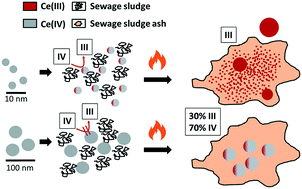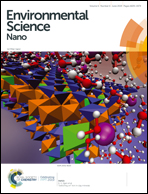Transformation of cerium dioxide nanoparticles during sewage sludge incineration†
Abstract
Production volumes of cerium dioxide nanoparticles (CeO2 NP) are predicted to increase in the near future, which will result in increasing amounts of CeO2 NP discharged into wastewater systems and their accumulation in the sewage sludge. At the same time, thermal treatments of sewage sludge, especially incineration, are gaining in importance. Therefore, knowledge on the physical–chemical transformations of CeO2 NP during wastewater treatment and sludge incineration is critical for assessing possible (eco-) toxicological effects related to the increased use of CeO2 NP. We, thus, incinerated unspiked municipal sewage sludge as well as sludge spiked with CeO2 of different particle sizes (4 nm (CeO2-s1), 26 nm (CeO2-s2) and >16 μm (CeO2-s3)) in a pilot fluidized bed reactor to investigate the (size dependent) transformation of CeO2 under conditions mimicking full-scale incineration facilities. We used Ce K- and LIII-edge X-ray absorption spectroscopy (XAS) complemented by analytical electron microscopy to assess the changes in Ce speciation and to characterize the morphology of the pristine and the transformed Ce-(nano)particles. After one week of incubation in digested sludge under anaerobic conditions, CeO2-s1 already showed partial reduction (≈40%) to a Ce(III)-phase. Cerium dioxide of larger particle size (CeO2-s2 and -s3) was less reactive and did not show any detectable reduction within the same reaction time. Incineration of the sludge in general led to a further reduction of Ce, irrespective of whether the Ce was spiked (CeO2-s1, CeO2-s2, CeO2-s3) or already present in the sludge. Reduction during incineration was nearly complete for CeO2-s1 but much less pronounced for CeO2-s2 and -s3. Ce(IV) in larger (primary-) particle sizes thus was more resistant to reduction during anaerobic digestion and incineration. In addition, elemental distribution maps of the CeO2-s1 fly ash revealed elevated Ce signal intensities evenly distributed over areas of several 100 nm. The complementary results obtained from spectroscopic and microscopic analyses indicate that incineration led to the reductive decomposition of the initial CeO2-s1 NP and the sequestration of Ce(III) into a mineralogical phase with probably allanite-like local Ce(III) coordination. Our results, thus, highlight the importance of particle size and the surrounding matrix both affecting the transformation of CeO2 during sewage sludge incineration.



 Please wait while we load your content...
Please wait while we load your content...